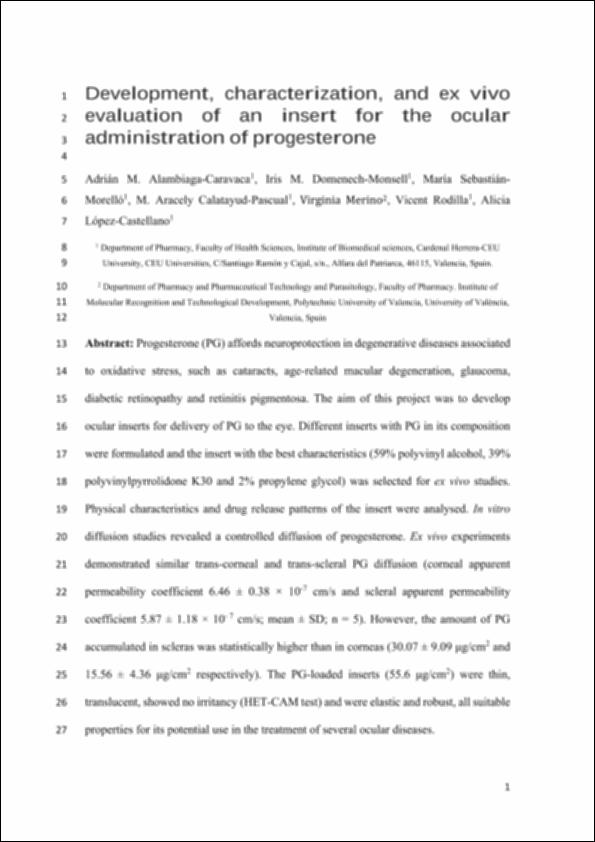Please use this identifier to cite or link to this item:
http://hdl.handle.net/10637/15007Development, characterization, and "ex vivo" evaluation of an insert for the ocular administration of progesterone
| Title: | Development, characterization, and "ex vivo" evaluation of an insert for the ocular administration of progesterone |
| Authors : | Alambiaga Caravaca, Adrián Miguel Domenech Monsell, Iris M. Sebastián Morelló, María Calatayud Pascual, María Aracely Merino, Virginia Rodilla Alama, Vicente López Castellano, Alicia Cristina |
| Keywords: | Vista; Eyesight; Tratamiento médico; Medical treatment; Enfermedad; Diseases; Medicamento; Drugs |
| Publisher: | Elsevier |
| Citation: | Alambiaga-Caravaca, A.M., Domenech-Monsell, I.M., Sebastián-Morelló, M., Calatayud-Pascual, M.A., Merino, V., Rodilla, V. & López-Castellano, A. (2021). Development, characterization, and "ex vivo" evaluation of an insert for the ocular administration of progesterone. International Journal of Pharmaceutics, vol. 606, art. 120921 (05 sep.). DOI: https://doi.org/10.1016/j.ijpharm.2021.120921 |
| Abstract: | Progesterone (PG) affords neuroprotection in degenerative diseases associated to oxidative stress, such as cataracts, age-related macular degeneration, glaucoma, diabetic retinopathy and retinitis pigmentosa. The aim of this project was to develop ocular inserts for delivery of PG to the eye. Different inserts with PG in its composition were formulated and the insert with the best characteristics (59% polyvinyl alcohol, 39% polyvinylpyrrolidone K30 and 2% propylene glycol) was selected for ex vivo studies. Physical characteristics and drug release patterns of the insert were analysed. In vitro diffusion studies revealed a controlled diffusion of progesterone. Ex vivo experiments demonstrated similar trans-corneal and trans-scleral PG diffusion (corneal apparent permeability coefficient 6.46 ± 0.38 × 10-7 cm/s and scleral apparent permeability coefficient 5.87 ± 1.18 × 10- 7 cm/s; mean ± SD; n = 5). However, the amount of PG accumulated in scleras was statistically higher than in corneas (30.07 ± 9.09 μg/cm2 and 15.56 ± 4.36 μg/cm2 respectively). The PG-loaded inserts (55.6 μg/cm2) were thin, translucent, showed no irritancy (HET-CAM test) and were elastic and robust, all suitable properties for its potential use in the treatment of several ocular diseases. |
| Description: | This is the pre-peer reviewed version of the following article: Alambiaga-Caravaca, A.M., Domenech-Monsell, I.M., Sebastián-Morelló, M., Calatayud-Pascual, M.A., Merino, V., Rodilla, V. & López-Castellano, A. (2021). Development, characterization, and "ex vivo" evaluation of an insert for the ocular administration of progesterone. International Journal of Pharmaceutics, vol. 606, art. 120921 (05 sep.), which has been published in final form at: https://doi.org/10.1016/j.ijpharm.2021.120921 Este es el pre-print del siguiente artículo : Alambiaga-Caravaca, A.M., Domenech-Monsell, I.M., Sebastián-Morelló, M., Calatayud-Pascual, M.A., Merino, V., Rodilla, V. & López-Castellano, A. (2021). Development, characterization, and "ex vivo" evaluation of an insert for the ocular administration of progesterone. International Journal of Pharmaceutics, vol. 606, art. 120921 (05 sep.), que se ha publicado de forma definitiva en : https://doi.org/10.1016/j.ijpharm.2021.120921 |
| URI: | http://hdl.handle.net/10637/15007 |
| Rights : | http://creativecommons.org/licenses/by-nc-nd/4.0/deed.es |
| ISSN: | 0378-5173 |
| Issue Date: | 5-Sep-2021 |
| Center : | Universidad Cardenal Herrera-CEU |
| Appears in Collections: | Dpto. Farmacia |
Items in DSpace are protected by copyright, with all rights reserved, unless otherwise indicated.


